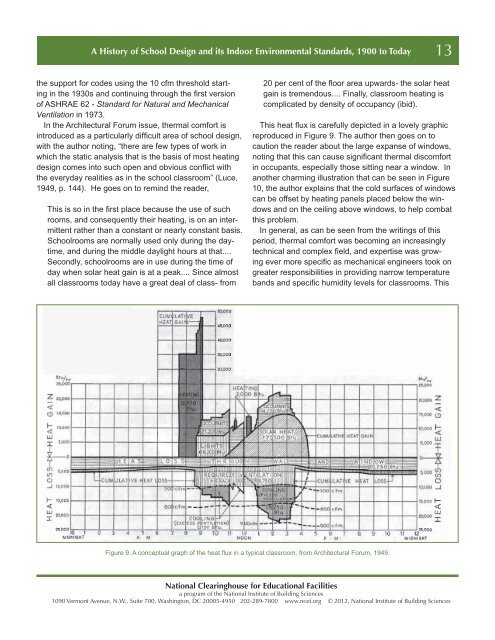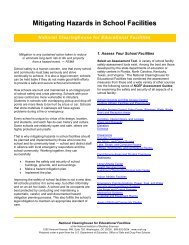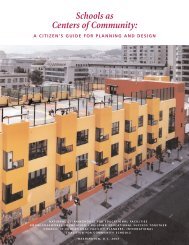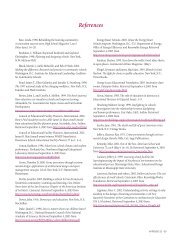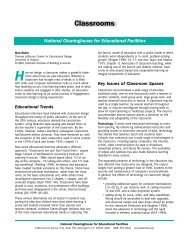A History of School Design and its Indoor - National Clearinghouse ...
A History of School Design and its Indoor - National Clearinghouse ...
A History of School Design and its Indoor - National Clearinghouse ...
Create successful ePaper yourself
Turn your PDF publications into a flip-book with our unique Google optimized e-Paper software.
A <strong>History</strong> <strong>of</strong> <strong>School</strong> <strong>Design</strong> <strong>and</strong> <strong>its</strong> <strong>Indoor</strong> Environmental St<strong>and</strong>ards, 1900 to Today<br />
the support for codes using the 10 cfm threshold starting<br />
in the 1930s <strong>and</strong> continuing through the fi rst version<br />
<strong>of</strong> ASHRAE 62 - St<strong>and</strong>ard for Natural <strong>and</strong> Mechanical<br />
Ventilation in 1973.<br />
In the Architectural Forum issue, thermal comfort is<br />
introduced as a particularly diffi cult area <strong>of</strong> school design,<br />
with the author noting, “there are few types <strong>of</strong> work in<br />
which the static analysis that is the basis <strong>of</strong> most heating<br />
design comes into such open <strong>and</strong> obvious confl ict with<br />
the everyday realities as in the school classroom” (Luce,<br />
1949, p. 144). He goes on to remind the reader,<br />
This is so in the fi rst place because the use <strong>of</strong> such<br />
rooms, <strong>and</strong> consequently their heating, is on an intermittent<br />
rather than a constant or nearly constant basis.<br />
<strong>School</strong>rooms are normally used only during the daytime,<br />
<strong>and</strong> during the middle daylight hours at that....<br />
Secondly, schoolrooms are in use during the time <strong>of</strong><br />
day when solar heat gain is at a peak.... Since almost<br />
all classrooms today have a great deal <strong>of</strong> class- from<br />
<strong>National</strong> <strong>Clearinghouse</strong> for Educational Facilities<br />
a program <strong>of</strong> the <strong>National</strong> Institute <strong>of</strong> Building Sciences<br />
1090 Vermont Avenue, N.W., Suite 700, Washington, DC 20005-4950 202-289-7800 www.ncef.org © 2012, <strong>National</strong> Institute <strong>of</strong> Building Sciences<br />
13<br />
20 per cent <strong>of</strong> the fl oor area upwards- the solar heat<br />
gain is tremendous.... Finally, classroom heating is<br />
complicated by density <strong>of</strong> occupancy (ibid).<br />
This heat fl ux is carefully depicted in a lovely graphic<br />
reproduced in Figure 9. The author then goes on to<br />
caution the reader about the large expanse <strong>of</strong> windows,<br />
noting that this can cause signifi cant thermal discomfort<br />
in occupants, especially those sitting near a window. In<br />
another charming illustration that can be seen in Figure<br />
10, the author explains that the cold surfaces <strong>of</strong> windows<br />
can be <strong>of</strong>fset by heating panels placed below the windows<br />
<strong>and</strong> on the ceiling above windows, to help combat<br />
this problem.<br />
In general, as can be seen from the writings <strong>of</strong> this<br />
period, thermal comfort was becoming an increasingly<br />
technical <strong>and</strong> complex fi eld, <strong>and</strong> expertise was growing<br />
ever more specifi c as mechanical engineers took on<br />
greater responsibilities in providing narrow temperature<br />
b<strong>and</strong>s <strong>and</strong> specifi c humidity levels for classrooms. This<br />
Figure 9. A conceptual graph <strong>of</strong> the heat fl ux in a typical classroom, from Architectural Forum, 1949.


